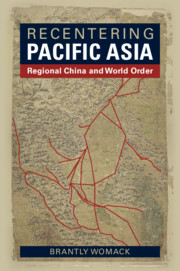Book contents
- Recentering Pacific Asia
- Recentering Pacific Asia
- Copyright page
- Contents
- Figures
- Table
- Author and Commentators
- Acknowledgements
- Note on the Cover Map
- Introduction
- 1 Continuities in China’s Pacific Asian Centrality
- 2 Thin Connectivity
- Commentary
- 3 Sharp Connectivity
- Commentary
- 4 Thick Connectivity
- Commentary
- 5 China, Pacific Asia, and Reconfiguring a Multinodal World
- Commentary
- 6 Global Power Rivalry, Pacific Asia, and World Order
- Bibliography
- Index
Introduction
Published online by Cambridge University Press: 03 August 2023
- Recentering Pacific Asia
- Recentering Pacific Asia
- Copyright page
- Contents
- Figures
- Table
- Author and Commentators
- Acknowledgements
- Note on the Cover Map
- Introduction
- 1 Continuities in China’s Pacific Asian Centrality
- 2 Thin Connectivity
- Commentary
- 3 Sharp Connectivity
- Commentary
- 4 Thick Connectivity
- Commentary
- 5 China, Pacific Asia, and Reconfiguring a Multinodal World
- Commentary
- 6 Global Power Rivalry, Pacific Asia, and World Order
- Bibliography
- Index
Summary
Pacific Asia, comprised of Northeast Asia, Greater China, and Southeast Asia, has surpassed the combined production of the United States and Europe, and its intraregional economic cohesiveness exceeds that of either the EU or North America. Pacific Asia has emerged gradually and without major conflict, but it should be taken seriously as a region. China is primarily a regional power, but in a prosperous region deeply interconnected to the rest of the world. The United States tends to view China as a lone global competitor, but its global presence and strength rest on its centrality to Pacific Asia. Understanding China in its region is the first task of this book, followed by the challenge of rethinking the global order in terms of a multinodal matrix rather than a bipolar competition of great powers. This requires background on the evolution of the Pacific Asian configuration, including China’s premodern centrality as well as the splintering of the region by European colonialism. Rethinking is aided by commentaries from four of Asia’s leading thinkers about international relationships.
Keywords
- Type
- Chapter
- Information
- Recentering Pacific AsiaRegional China and World Order, pp. 1 - 22Publisher: Cambridge University PressPrint publication year: 2023



